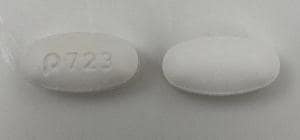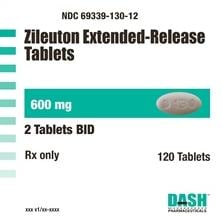Dosage Forms
Excipient information presented when available (limited, particularly for generics); consult specific product labeling. [DSC] = Discontinued product
Tablet, Oral:
Zyflo: 600 mg [scored]
Tablet Extended Release 12 Hour, Oral:
Zyflo CR: 600 mg [DSC]
Generic: 600 mg
Pharmacology
Mechanism of Action
Specific 5-lipoxygenase inhibitor which inhibits leukotriene formation. Leukotrienes augment neutrophil and eosinophil migration, neutrophil and monocyte aggregation, leukocyte adhesion, increased capillary permeability, and smooth muscle contraction (which contribute to inflammation, edema, mucous secretion, and bronchoconstriction in the airway of the asthmatic).
Pharmacokinetics/Pharmacodynamics
Absorption
Well-absorbed
Distribution
1.2 L/kg
Metabolism
Hepatic and gastrointestinal; zileuton and N-dehydroxylated metabolite can be metabolized via CYP1A2, 2C9, and 3A4
Excretion
Urine (~95% primarily as metabolites); feces (~2%)
Time to Peak
Immediate release: 1.7 hours
Half-Life Elimination
~3 hours
Protein Binding
93%, primarily albumin
Use in Specific Populations
Special Populations: Hepatic Function Impairment
The mean apparent plasma clearance of zileuton in subjects with hepatic impairment was approximately half the value of the healthy subjects. The percent binding of zileuton to plasma proteins after multiple dosing was significantly reduced in patients with moderate hepatic impairment.
Use: Labeled Indications
Asthma: Prophylaxis and chronic treatment of asthma in adults and children ≥12 years of age
Limitations of use: Not indicated for relief of acute bronchospasm
Contraindications
Hypersensitivity to zileuton or any component of the formulation; active liver disease or transaminase elevations ≥3 times ULN
Dosage and Administration
Dosing: Adult
Asthma: Oral:
Immediate release: 600 mg 4 times daily
Extended release: 1,200 mg twice daily
Dosing: Geriatric
Refer to adult dosing.
Dosing: Pediatric
Asthma: Note: Current guidelines do not describe a role for zileuton in the management of asthma (GINA 2018); not routinely used. Children ≥12 years and Adolescents:
Immediate release: Oral: 600 mg 4 times daily; maximum daily dose: 2,400 mg/day
Extended release: Oral: 1,200 mg twice daily; maximum daily dose: 2,400 mg/day
Administration
Immediate release: Administer without regard to meals.
Extended release: Do not crush, cut, or chew tablet; administer within 1 hour after morning and evening meals.
Dietary Considerations
Immediate release: Take without regard to meals.
Extended release: Take with food.
Storage
Store tablets at 20°C to 25°C (68°F to 77°F). Protect from light.
Zileuton Images
Drug Interactions
CloZAPine: CYP1A2 Inhibitors (Weak) may increase the serum concentration of CloZAPine. Management: Drugs listed as exceptions to this monograph are discussed in further detail in separate drug interaction monographs. Monitor therapy
Loxapine: Agents to Treat Airway Disease may enhance the adverse/toxic effect of Loxapine. More specifically, the use of Agents to Treat Airway Disease is likely a marker of patients who are likely at a greater risk for experiencing significant bronchospasm from use of inhaled loxapine. Management: This is specific to the Adasuve brand of loxapine, which is an inhaled formulation. This does not apply to non-inhaled formulations of loxapine. Avoid combination
Pimozide: Zileuton may increase the serum concentration of Pimozide. Avoid combination
Propranolol: Zileuton may increase the serum concentration of Propranolol. Monitor therapy
Theophylline Derivatives: CYP1A2 Inhibitors (Weak) may increase the serum concentration of Theophylline Derivatives. Exceptions: Dyphylline. Monitor therapy
TiZANidine: CYP1A2 Inhibitors (Weak) may increase the serum concentration of TiZANidine. Management: Avoid these combinations when possible. If combined use is necessary, initiate tizanidine at an adult dose of 2 mg and increase in 2 to 4 mg increments based on patient response. Monitor for increased effects of tizanidine, including adverse reactions. Consider therapy modification
Warfarin: Zileuton may increase the serum concentration of Warfarin. Monitor therapy
Adverse Reactions
>10%: Central nervous system: Headache (23% to 25%)
1% to 10%:
Cardiovascular: Chest pain
Central nervous system: Pain (8%), dizziness, drowsiness, hypertonia, insomnia, malaise, nervousness
Dermatologic: Pruritus, skin rash
Gastrointestinal: Dyspepsia (8%), nausea (5% to 6%), abdominal pain (5%), diarrhea (5%), constipation, flatulence, vomiting
Genitourinary: Urinary tract infection, vaginitis
Hematologic & oncologic: Leukopenia (1% to 3%), lymphadenopathy
Hepatic: Increased serum ALT (≥3 x ULN: 2% to 5%), hepatotoxicity
Hypersensitivity: Hypersensitivity reaction
Neuromuscular & skeletal: Myalgia (7%), weakness (4%), arthralgia, neck pain, neck stiffness
Ophthalmic: Conjunctivitis
Respiratory: Upper respiratory tract infection (9%), sinusitis (7%), pharyngolaryngeal pain (5%)
Miscellaneous: Fever
<1%, postmarketing, and/or case reports: Behavioral changes, hepatic failure, hepatitis, hyperbilirubinemia, jaundice, mood changes, sleep disorder, suicidal tendencies, urticaria
Warnings/Precautions
Concerns related to adverse effects:
- Hepatotoxicity: There have been reports of hepatic adverse effects (elevated transaminase levels); serum ALT should be monitored. Females >65 years and patients with pre-existing elevated transaminases may be at greater risk. Discontinue therapy and follow transaminases until normal if patients develop clinical signs/symptoms of liver dysfunction or with transaminase levels >5 times ULN; use caution with history of liver disease and/or in those patients who consume substantial quantities of ethanol.
- Neuropsychiatric events: Postmarketing reports of behavioral changes and sleep disorders have been noted.
Concurrent drug therapy issues:
- Sedatives: CNS effects may be potentiated when used with other sedative drugs or ethanol.
Special populations:
- Elderly: Females >65 years of age may be at increased risk for ALT elevations. Pharmacokinetics were similar in older adults (≥65 years) compared to younger adults.
- Pediatric: Due to the risk of hepatotoxicity, the manufacturer does not recommend use of zileuton in children <12 years of age.
Other warnings/precautions:
- Reversal of bronchospasm: Not indicated for the reversal of bronchospasm in acute asthma attacks, including status asthmaticus; therapy may be continued during acute asthma exacerbations.
Monitoring Parameters
Hepatic transaminases (prior to initiation and during therapy), specifically monitor serum ALT (prior to initiation, once-a-month for the first 3 months, every 2 to 3 months for the remainder of the first year, and periodically thereafter for patients receiving long-term therapy)
Pregnancy
Pregnancy Considerations
Uncontrolled asthma is associated with adverse events in pregnancy (increased risk of perinatal mortality, preeclampsia, preterm birth, low birth weight infants). Poorly controlled asthma or asthma exacerbations may have a greater fetal/maternal risk than what is associated with appropriately used asthma medications (BTS 2016; GINA 2018). If a leukotriene modifier is needed during pregnancy, other agents are preferred (ACOG [Dombrowski] 2008).
Data collection to monitor pregnancy and infant outcomes following exposure to asthma medications in pregnancy is ongoing. Health care providers are encouraged to enroll females exposed to zileuton during pregnancy in the MothersToBaby Pregnancy Studies conducted by the Organization of Teratology Information Specialists (1-877-311-8972 or http://mothertobaby.org/pregnancy-studies/).
Patient Education
- Discuss specific use of drug and side effects with patient as it relates to treatment. (HCAHPS: During this hospital stay, were you given any medicine that you had not taken before? Before giving you any new medicine, how often did hospital staff tell you what the medicine was for? How often did hospital staff describe possible side effects in a way you could understand?)
- Patient may experience headache, nausea, abdominal pain, heartburn, sore throat, stuffy nose, common cold symptoms, muscle pain, or diarrhea. Have patient report immediately to prescriber signs of liver problems (dark urine, fatigue, lack of appetite, nausea, abdominal pain, light-colored stools, vomiting, or yellow skin), trouble sleeping, or behavioral changes (HCAHPS).
- Educate patient about signs of a significant reaction (eg, wheezing; chest tightness; fever; itching; bad cough; blue skin color; seizures; or swelling of face, lips, tongue, or throat). Note: This is not a comprehensive list of all side effects. Patient should consult prescriber for additional questions.
Intended Use and Disclaimer: Should not be printed and given to patients. This information is intended to serve as a concise initial reference for health care professionals to use when discussing medications with a patient. You must ultimately rely on your own discretion, experience, and judgment in diagnosing, treating, and advising patients.



